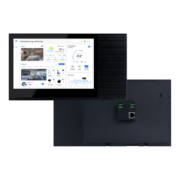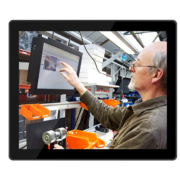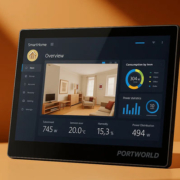What is an Embedded Touch Screen?
Embedded touch screens are a cornerstone of modern industrial, commercial, and consumer electronics, providing an intuitive, interactive interface for a wide range of devices. From smart home systems to industrial control panels, these screens allow users to interact directly with the technology through touch, eliminating the need for physical buttons or other input devices. But what exactly is an embedded touch screen, and why is it so important in today’s digital landscape?
In this article, we’ll explore the definition, applications, advantages, and technical considerations of embedded touch screens, shedding light on why they are indispensable in various industries.
Understanding Embedded Touch Screens
An embedded touch screen is a touch-sensitive display that is integrated directly into a device, where it serves as the primary interface for interaction. The term “embedded” refers to the fact that the touch screen is built into the device, typically as part of a custom hardware or software solution. Unlike traditional standalone touch screens, embedded versions are designed to function within specific devices or systems, providing a seamless user experience within an enclosure or housing.
Typically, these touch screens use either capacitive or resistive technology, depending on the application’s needs.
- Capacitive Touch Screens: These are the most common in modern devices and offer highly responsive touch interaction. They work by detecting the electrical properties of the human finger, making them ideal for precision control and multi-touch functions.
- Resistive Touch Screens: Less common but still used in some industrial applications, these screens work by sensing pressure on the screen and can be activated by any input device, including fingers, styluses, or gloves.
Key Features of Embedded Touch Screens
- Integrated Functionality:
Embedded touch screens are typically part of a larger system, such as an industrial control panel, kiosk, or smart home device. They integrate directly into the design, providing the user with real-time access to controls, settings, and status updates in a clean, compact, and ergonomic package. - Touch Sensitivity:
These screens respond to user interactions, allowing them to detect taps, swipes, pinches, and other multi-touch gestures. This level of interactivity enhances the user experience, making it more intuitive than traditional buttons or physical interfaces. - Durability and Customization:
Embedded touch screens are built to endure harsh environments. Many models are resistant to dust, water, and temperature variations, which makes them ideal for industrial and outdoor applications. Furthermore, manufacturers can customize these screens in terms of size, resolution, screen type, and mounting options. - Wide Range of Applications:
These touch screens are highly versatile and can be used in everything from medical devices to industrial machines. They enable users to interact with the system efficiently, control settings, and access valuable data—all through a single touch interface.
Applications of Embedded Touch Screens
Embedded touch screens are used across a wide array of industries. Some of the most common applications include:
- Industrial Automation:
In industrial settings, embedded touch screens are integrated into machines and control panels for real-time monitoring and control. Devices such as Portworld’s YC-15EBT 15-inch Embedded Touch Screen Monitor are used for machine monitoring, control systems, and factory floor operations. They allow operators to easily adjust settings, view diagnostic information, and manage production processes with a few taps on the screen. - Retail and Kiosks:
Retailers use embedded touch screens in self-service kiosks, point-of-sale (POS) systems, and interactive product displays. These devices enhance customer experiences by allowing them to browse, order, and pay with ease. In this case, touch screens also serve as an effective way to display real-time product information. - Healthcare:
In medical settings, embedded touch screens are used in diagnostic equipment, patient management systems, and mobile health devices. They provide doctors and healthcare workers with easy access to patient data, lab results, and other critical information while remaining hygienic and easy to clean. - Transportation and Vehicles:
Many modern vehicles, including buses, taxis, and delivery trucks, use embedded touch screens for navigation, fleet management, and in-vehicle entertainment systems. These systems help drivers interact with vehicle data, track routes, and control media and communication features. - Smart Home Control:
Embedded touch screens are becoming more common in smart homes, enabling users to manage home automation systems, security settings, lighting, HVAC, and more. Devices like Portworld’s YC-SM10P 10-inch Smart Home Control Panel use touch screen interfaces to provide intuitive control over home devices. - Military and Aerospace:
In high-stress environments, such as military operations or aerospace applications, embedded touch screens offer a reliable and intuitive interface for controlling critical systems. These screens are often designed to meet stringent durability and safety standards, ensuring their functionality in challenging environments.
Advantages of Embedded Touch Screens
- Space-Saving Design:
Since embedded touch screens are integrated into the device or system, they eliminate the need for additional physical buttons, knobs, or switches, saving valuable space and streamlining the design. - User-Friendly Interaction:
Touch screens provide a more natural and intuitive interface compared to traditional input devices. Users can interact directly with the display, making the operation faster and more efficient, especially for complex tasks. - Customization:
Embedded touch screens are highly customizable in terms of screen size, resolution, and interface design. Manufacturers can tailor the interface to suit the specific needs of the application, ensuring optimal user experience. - Cost-Effective:
While embedded touch screens offer many benefits, they can also reduce the overall cost of a device. By integrating the user interface into the device itself, manufacturers eliminate the need for additional components like physical buttons and mechanical switches. - Durability and Reliability:
Many embedded touch screens are built to withstand harsh environments. Whether it’s exposure to moisture, extreme temperatures, or rough handling, these screens are designed to perform reliably under demanding conditions.
Considerations When Choosing an Embedded Touch Screen
- Environmental Factors:
Consider the environment in which the touch screen will be used. Will it be exposed to extreme temperatures, dust, or moisture? If so, look for touch screens with IP65 or higher ratings for water and dust resistance. - Touch Sensitivity:
Ensure that the touch screen offers the sensitivity needed for your application. Multi-touch capability is often essential for complex interactions, while single-touch screens may suffice for simpler tasks. - Display Quality:
Depending on your use case, the resolution and brightness of the display may be important. High-definition screens with wide viewing angles are crucial for clear visibility in bright environments or from various angles. - Customization and Integration:
For specialized applications, consider working with a manufacturer that offers custom touch screen solutions. OEM/ODM options allow you to tailor the interface, size, and features to meet specific needs.
An embedded touch screen is much more than just a display—it is the heart of modern user interfaces, enabling interaction with industrial, commercial, and consumer devices. From Portworld’s rugged industrial panels to customizable smart home control systems, embedded touch screens are an essential component of the increasingly interconnected world.





